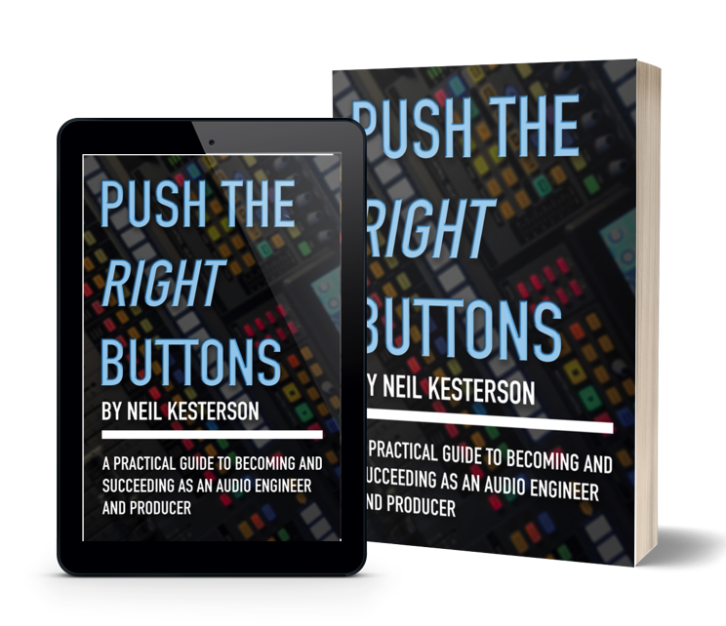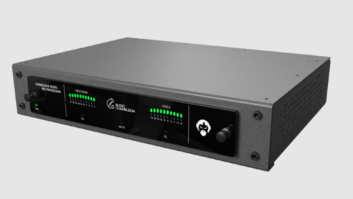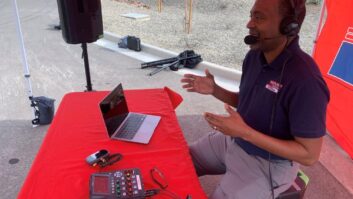If there was ever a single book that could give aspiring audio engineers an accurate look at the career, “Push the Right Buttons: A Practical Guide to Becoming and Succeeding as an Audio Engineer and Producer” is it. Written by veteran audio engineer Neil Kesterson of Dynamix Productions, and available in ebook or paperback form, Push the Right Buttons is a well-written, candid and comprehensive tour of the audio engineer profession.
For the record, Kesterson’s audio production credits include “Chicago Fire and Law & Order: SVU” on NBC, and movies such as “War for the Planet of the Apes” and “Diary of a Wimpy Kid: Dog Days.” He’s been a sound designer since 1985.
In its opening chapter title, Push the Right Buttons asks its readers to think hard about why they want to be an audio engineer. “[This is] a plea for you to look inside yourself and honestly assess your reasons for taking a path into this world of twiddling knobs and pushing buttons,” Kesterson writes. “Of course, it’s more than that, but a lot of people will view you as just that — a ‘button pusher.’ You may also be regarded as an ‘audio nerd’, ‘gear head’, ‘DJ’, ‘audio dude’, ‘audio gal’, ‘one of the girls’, ‘one of the boys’, ‘You can’t stand there, I need to put a light there’, ‘You can’t stand there either’, or just ‘Hey you.’ And if you command a little respect, you may be called ‘Ears’ or ‘sound guy/girl.'”

For those aspiring audio engineers willing to endure this disrespect, Push the Right Buttons takes them on a thorough tour of the profession. It covers educational options from college to striking out and learning on the job; how to land that first job and move up from there; how to market yourself; and how to work with clients, directors, producers and talent — or to let the last category do their own thing when they are pros like William Shatner and know their craft cold.
“If there’s one thing I learned about Shatner’s working method, it’s that he will almost always find the right read by himself,” writes Kesterson. “He’s one of the best self-directing voice-over actors I’ve ever worked with. He would start off by reading a line, such as ‘A call came in at 4:32 AM.’ He would then re-read it several more times, each with different intensity and timing. Finally, he would land on the perfect one, and then move on to the next line. You could watch his actor gears turning as he found the truth in the line.”
Push the Right Buttons is also peppered with illustrative stories from Kesterson’s own career, and how he worked his way to the top over close to four decades. “For years I regretted not having that piece of paper that said ‘Bachelor of Arts’’ on it, but I’ve gotten over it,” he writes. “To my knowledge, it never hindered my career, but a few supervisors got persnickety about it. My response, which usually shut them up, was that there wasn’t a degree for what I do when I was hired. I count myself lucky because I’ve only worked three full-time jobs, if you count owning my own business as one of them. I’ve also worked on many broadcast, live audio, film, video and recording crews. I taught a college audio course, I advise high school and college media programs and I’ve mentored too many interns to count.”
Add in further chapters about engineering and recording concepts, audio engineering tricks and advice and a detailed history of audio engineering going back to Édouard-Léon Scott de Martinville’s paper-based audio recordings in 1854 — you can hear them here — and Push the Right Buttons is a well-written, easy-to-ready and yet encyclopedic summary of the audio engineering profession. For those considering such a career, or others just wanting to learn about it, Push the Right Buttons pushes the right buttons.
More information on the book can be found here.












